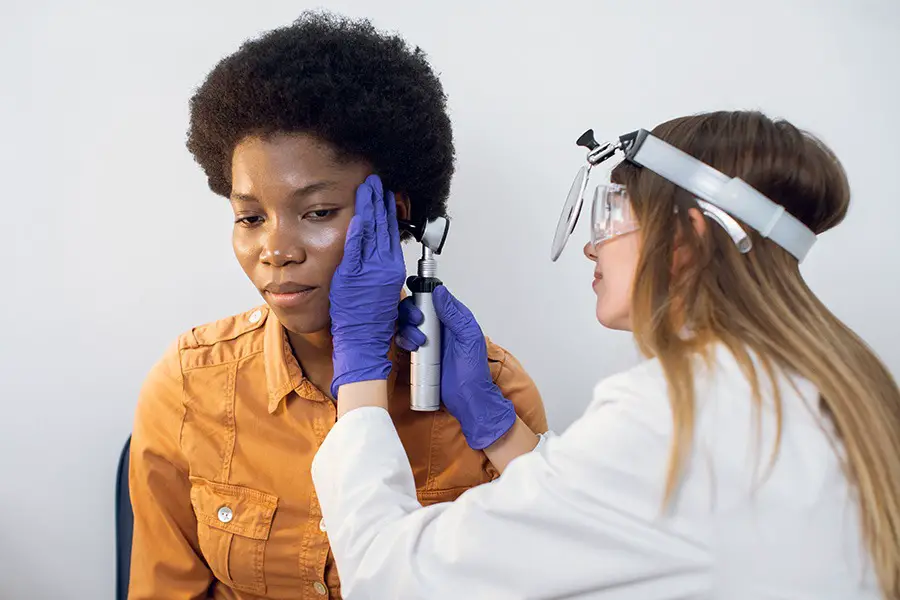Introduction
Sensorineural hearing loss (SNHL) is a common condition that affects many seniors, especially as they age. It occurs when there is damage to the inner ear or the nerve that carries sound signals to the brain. SNHL can make it hard to hear and understand speech, especially in noisy environments. However, thanks to the rapid development of technology, there are many solutions available that can help seniors with SNHL improve their hearing and quality of life. In this blog post, we will explore some of these technologies, such as hearing aids, cochlear implants, smartphone apps, assistive devices, and artificial intelligence and machine learning. We will also discuss how these technologies empower and support seniors with SNHL in their daily activities and communication.
This blog post is meant to be informative and helpful, but it is not a substitute for professional medical advice. If you have any questions or concerns about your hearing or SNHL, please consult with your healthcare provider for specific guidance and diagnosis. Now, let us begin our journey through the world of SNHL technology and see how it can make a difference for seniors with SNHL.
OTC Hearing Aid Pair
Experience the world like never before with the RCA OTC Behind-the-Ear Hearing Aid. Our advanced digital technology ensures that every sound is crystal clear and vibrant, allowing you to fully immerse yourself in life’s experiences. Whether it’s the laughter of loved ones or the music that moves you, our hearing aid brings back the joy of every moment.
Say goodbye to the hassle of appointments and prescriptions. The RCA OTC Hearing Aid is designed to meet the needs of individuals without the need for a prescription. With its seamless setup and user-friendly design, you can effortlessly enhance your hearing abilities and stay connected to the world around you. Simply unpack, wear, and enjoy improved auditory perception instantly.
Experience optimal comfort and style with our discreet behind-the-ear design. The thin tube design allows you to wear glasses comfortably, so you can enjoy clear hearing while maintaining your personal sense of style. Plus, our rechargeable battery ensures long-lasting power, eliminating the inconvenience of constantly replacing small batteries. Elevate your hearing experience with the RCA OTC Hearing Aid and embrace the world with confidence.
Hearing Aids and Sensorineural Hearing Loss
A Technological Journey
One of the most widely used and effective interventions for sensorineural hearing loss is hearing aids. Hearing aids are devices that amplify sound and deliver it to the ear. They have evolved significantly over time, from simple ear trumpets to sophisticated digital gadgets. Modern hearing aids have features such as noise reduction, directional microphones, and connectivity with other devices, which can enhance the hearing experience for people with SNHL.
The future of hearing aids is also promising, as researchers and developers are working on creating “smart” hearing aids that can analyze the sound environment and adjust accordingly. These hearing aids could also learn from user preferences and feedback and optimize their performance. These innovations show how technology can adapt to meet the needs of people with SNHL and provide them with better hearing solutions.
What to Look for in Inexpensive Hearing Aids
The Future of Cochlear Implants for Sensorineural Hearing Loss
Another groundbreaking invention that has changed the lives of many people with severe to profound sensorineural hearing loss is cochlear implants. Cochlear implants are devices that bypass the damaged part of the inner ear and stimulate the auditory nerve directly with electrical signals. Unlike hearing aids, which amplify sound, cochlear implants create sound sensations in the brain.
The horizon of cochlear implant technology is full of possibilities, as current research is focusing on improving the sound quality, speech understanding in noisy situations, and user satisfaction of these devices. Moreover, there is ongoing exploration of combining cochlear implants with drug delivery systems that could protect or regenerate the auditory nerve cells, which could enhance the hearing outcomes. These advancements demonstrate the potential of technology to revolutionize the treatment of sensorineural hearing loss.
Smartphone Apps
Aiding the Sensorineural Hearing Loss Community
With the advent of smartphones, a new realm of assistive technology has emerged for people with sensorineural hearing loss. Various apps now offer features such as real-time captioning, sign language interpretation, and sound amplification. For seniors, who might experience other forms of age-related sensory decline, these apps are easy to use and accessible.
As app technology continues to evolve, future versions could offer more personalized and user-friendly options. For example, apps could be designed to “learn” from user behavior and automatically adjust the settings of connected devices based on different environments. The growing integration of health tracking in smartphones could also pave the way for apps that monitor auditory health and provide alerts or recommendations. These features could make smartphones an even more essential ally for seniors with SNHL
Technological Innovations
Assistive Devices for Sensorineural Hearing Loss
Besides hearing aids and cochlear implants, there are other types of assistive listening devices (ALDs) that can make daily life easier for seniors with SNHL. These include amplified phones, TV listening systems, and alerting devices that use visual signals or vibrations for alarms and doorbells. Technological innovations have also given rise to FM systems and induction loop systems, which can provide significant benefit in challenging listening environments like theaters or lecture halls.
Assistive devices are a testament to how technology can cater to specific needs. For seniors with SNHL, they can provide convenience and comfort in the home or public spaces. As technology advances, we can expect more innovative and tailored solutions to enhance the daily lives of people with SNHL.
CBD for Tinnitus: Can It Stop the Ringing?
Revolutionizing Sensorineural Hearing Loss Treatment Through AI and Machine Learning
AI and machine learning are exciting frontiers in the world of sensorineural hearing loss. AI technology is currently being used to improve hearing aid functionality by enabling these devices to learn from user preferences and adjust accordingly. Additionally, AI is being used to develop sophisticated speech recognition systems, which could be a game-changer for people with SNHL.
On the other hand, machine learning algorithms are being used to predict the success of cochlear implantation and to customize the device programming to individual patients. This approach could ensure better outcomes and patient satisfaction.
Success Stories Children Overcoming Sensorineural Hearing Loss
Despite the challenges associated with sensorineural hearing loss, many children show remarkable resilience and perseverance. There are many stories of children with SNHL who, with the help of early interventions, assistive technology, and educational accommodations, excel academically, thrive socially, and achieve amazing success. These stories inspire us and show us the possibilities that exist when barriers are removed and the right support is in place.
These success stories should not be seen as exceptions but as achievable goals. They highlight the importance of comprehensive support systems and the power of resilience, further strengthening the case for widespread and equitable access to interventions and resources for children with SNHL.
Conclusion
This exploration of the technological advancements for seniors with sensorineural hearing loss shows us a dynamic and rapidly progressing field. It is a field where creativity and compassion meet, as developers and researchers work tirelessly to improve the quality of life for people with SNHL.
The constant improvements in hearing aids, cochlear implants, smartphone apps, assistive devices, and the ongoing exploration of AI and machine learning promise a future where sensorineural hearing loss is no longer a barrier to communication and a fulfilling life. They promise a future where technology serves not just as a tool but also as a companion in navigating the world of sound.
As we move forward, it is important to stay informed about these advancements. It is not just about knowing the latest devices or apps; it is about understanding the capabilities of these technologies and how they can suit different needs. It is about making the most of these innovations in our pursuit of a world without barriers for those with SNHL.
While we celebrate these advancements, we must also remember the importance of continuous research and investment in this field. Only through ongoing innovation can we continue to improve the lives of seniors with SNHL.
Finally, the remarkable progress in this field gives us reasons to look to the future with optimism. It is a testament to human resilience and innovation, dedicated to improving the lives of those living with SNHL. This is the journey we are on, and it is a journey that holds promise for a more inclusive and accessible world.

Decoding Silence: An Analytical View on the Advances in Conductive Hearing Loss Research and Treatment
This analytical article sheds light on conductive hearing loss, offering an in-depth exploration of its genetic factors, treatment advances, and promising experimental therapies.

Embracing the Melody of Life: Navigating the Journey with Conductive Hearing Loss
A blog post delving into the experiences and challenges of living with conductive hearing loss, discussing its impact on everyday life, social interactions, mental health, and the potential benefits of hearing aids and cochlear implants.





